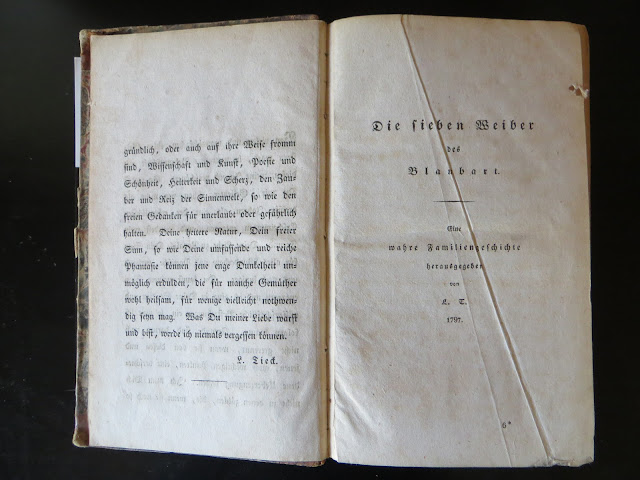Books bought for pennies from libraries anxious to shed themselves of cracked and aged tomes. But they're in better shape than most 200/300-year old beings.
The Seven Wives of Bluebeard: A True Family Story
Published by L. T. (Ludwig Tieck) 1797
With its foxed pages and fading and broken cover, not to mention its sweet, aged scent, the book manifests time.
Weimar, 1828. Two years before Goethe died. The book is a physical connection to a time and place accessible only by tangible objects (the ideas in the book, of course, are a connection of a different sort).













6 comments:
nice. this old paper is something else entirely.
my oldest one is a xenophon, anabasis in ancient greek, from 1823, and someone forgot their notes in it.
you are right there is somehting very physical about it. and how 200 yr old paper feels so very different than that from, say my 100yr old lenau one from yesterday. they surely must have produced it differently. ther eis some real tangible magic to it, like the colour of some old deep dark brown wood. or old glass, that has this too, sometimes...
have you actually read gruener heinrich? and if so which version? i didn't but have a couple here around and maybe -- as if -- plan to read one some time soon. i wanted to ask you something els ebut forgotten.
it was your Lenau photo that took me to my Tieck, looking for the paper first (your photos are so tactile).
i once read all those big bildungsromane to write something about building (your dear W. v. Humboldt as well). and green henry (the english feels wonderfully awkward) too. can't, however, remember the version. i do seem to remember it was one of those (mostly unattractive) goldmann's klassiker paperbacks.
Bildung! not building! I hate the way the word-processor thinks it knows what I'm trying to write.
bildung also needs to be built, no?
green henry and it's so nice, in english it's green henry and there is henry green too of whom i read far too little. and of tieck too. beautiful old letters.
yes the goldmann ones are always ugly.
i know again what i wanted to ask: how you liked the knausgaard angel one.
i'm about a third of the way through knausgaard's angel book. i like it, especially as i'm on the trail of the standing metaphor. the initial angels are standing, standing like statues, standing there -- don't miss the metaphor, the scene says. and i'm thinking/hoping that the angels, as they multiply and return to the beginning, will come with a corpus of standings i can use, perhaps, in conjunction with rilke's use of the metaphor.
but i'm not sure yet.
did you like the book?
same stage like you, about a third into it, got sidetracked & stuff to do at some point but now it's holidays so should finish it some time soonish.
you are right there is a lot of standing going on in there.
Post a Comment